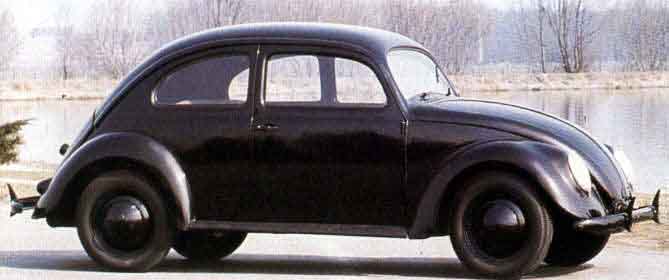Back in the 1930s, Germany was in the middle of its reindustrialization as a necessary step to get ready for the war that was already cooking in Hitler’s mind. Besides the reinforcement of the pure military industry, there was a strong recovery of the country’s economic infrastructure, what meant not only basic industry, but communications too. The plan for “die Deutsche Autobähne”, the German highways network was being deployed to.
In coordination with this, the German government of the time decided as well that the automotive industry should as well be a fundamental part of these plans, including the production of a cheap car that could be afforded by the average German family. That was the birth of one of the automobile industry icons: The Volkswagen Beetle. In fact, that is what Volkswagen meant: A car for the people, for the folk. Cars manufactured at that time were really expensive for an average German, who saw Mercedes, Opel, Maybach or BMW as unreachable items. The Great Depression of 1929 or the recovery from WWI were still too high economic loads for German citizens.
Incidentally, we shall mention that the industrialist awarded the necessary support to fulfill the project was Ferdinand Porsche. Curiously enough, we think nobody would associate the name Porsche to an average car for an average citizen in an average country, would they?
Despite the progression of WWII, still after the war the Beetle was there, and it did hit the right combination of price, market segment and product features. It was the right product at the right place in the right time to become an industrial success.
Not as powerful and fancy like Mercedes, Alfa Romeo, Citroen, Opel, Ford, Buick, Oldsmobile or Chevrolet; not as expensive either, it still was enough: Four wheels at a reasonable price that made the car acceptable for basic transportation needs, and was relatively easy and cheap to produce too. Factories were set up in Brazil, Mexico and China.
Later on, it even became fashionable: It’s typical and unique design (unchanged for decades!) came to a point in which it was perceived as cool, fancy and stylish. Not only it became an icon for the industry, but as well for a full generation of users. Even there have even been “revival editions”, special batches with this or that feature, that have been sold as limited series, with real high prices and margins.
It has been one of the best selling cars worldwide. To the point, in fact, that starting from the Beetle, a full line up was developed under the Volkswagen name, which, after having been a name designated to one specific car, has turned into a worldwide brand, and in fact, a worlwide industrial company. The Volkswagen brand is in fact one of the best recognized brands in the whole world, similar to Coca-Cola, General Motors, IBM or other. Under the Volkswagen brand, there are no more Beetles in production, but there are Golfs, Jettas, Passats, Touareg SUVs, trucks, minivans… and the industrial group own other brands such as Audi, Skoda, SEAT…
It looks that iPads are indeed repeating the Volkswagen story. For some, iPad turns to be the affordable Mac. If Mac is a Porsche, iPad is the Beetle… and Ferdinand Porsche himself has re-incarnated in Steve Jobs!
But as we write this, we even think the story goes further… we think the very first affordable Mac was the iPod/iPhone duo. That was indeed the very first Beetle, the first Mac experience for many people. As a matter of fact, would it be false to say that iPad’s success is based on the iPod’s or on the iPhone’s? And isn’t Mac Pros, Mac Airs as well benefitting from the halo of iPads?
Hi,
ReplyDeleteAnother good post. Here's my 2 cents on the subject. A reasonable customer would do a "gap analysis" to decide if s/he really needs to upgrade from an iPhone to iPad to a Mac. If portability is the key concern, then the user will never trade in a iPhone for a iPad or a Macbook. But I agree that the various cool features of the iPhone would have set the customer thinking; and once they got used to the new features, they would want more of the same. In a way, the iPhone was a proof-of-concept for Apple, who were encouraged to invest more in their iPad and Mac businesses because of the positive customer feedback. The reason Apple is the leader in its market segment, is that they effectively acted on customer feedback; that is they were nimble enough to quickly monetize those concepts before their rivals could do so.